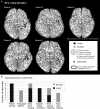Direct Exploration of the Role of the Ventral Anterior Temporal Lobe in Semantic Memory: Cortical Stimulation and Local Field Potential Evidence From Subdural Grid Electrodes
- PMID: 25491206
- PMCID: PMC4585516
- DOI: 10.1093/cercor/bhu262
Direct Exploration of the Role of the Ventral Anterior Temporal Lobe in Semantic Memory: Cortical Stimulation and Local Field Potential Evidence From Subdural Grid Electrodes
Abstract
Semantic memory is a crucial higher cortical function that codes the meaning of objects and words, and when impaired after neurological damage, patients are left with significant disability. Investigations of semantic dementia have implicated the anterior temporal lobe (ATL) region, in general, as crucial for multimodal semantic memory. The potentially crucial role of the ventral ATL subregion has been emphasized by recent functional neuroimaging studies, but the necessity of this precise area has not been selectively tested. The implantation of subdural electrode grids over this subregion, for the presurgical assessment of patients with partial epilepsy or brain tumor, offers the dual yet rare opportunities to record cortical local field potentials while participants complete semantic tasks and to stimulate the functionally identified regions in the same participants to evaluate the necessity of these areas in semantic processing. Across 6 patients, and utilizing a variety of semantic assessments, we evaluated and confirmed that the anterior fusiform/inferior temporal gyrus is crucial in multimodal, receptive, and expressive, semantic processing.
Keywords: anterior fusiform; basal temporal language area; semantic memory; subdural electrodes; ventral anterior temporal lobe.
© The Author 2014. Published by Oxford University Press.
Figures




References
-
- Amano S, Kondo T. 1999. Japanese NTT database series: lexical properties of Japanese (I). Tokyo: Sanseido.
-
- Amano S, Kondo T. 2000. Japanese NTT database series: lexical properties of Japanese, word-frequency (II). Tokyo: Sanseido.
Publication types
MeSH terms
Grants and funding
LinkOut - more resources
Full Text Sources
Other Literature Sources
Medical

